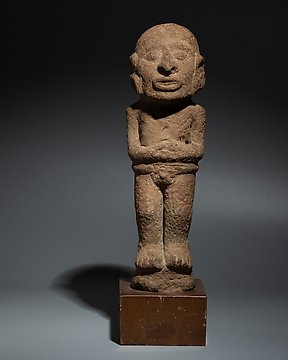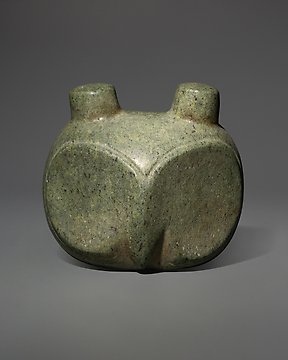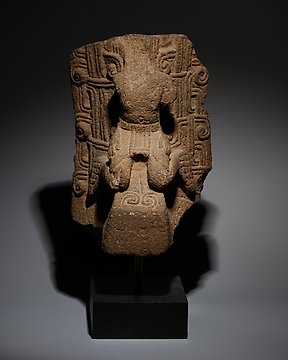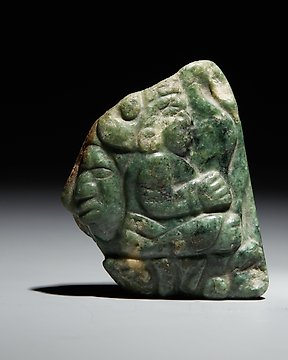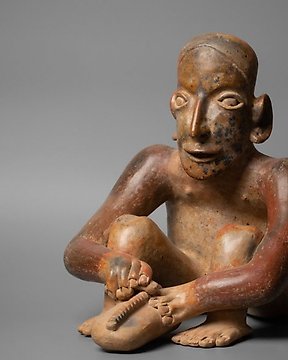BEL OBJET ANCIEN DE QUALITE BIEN EMBALLE ET ACHEMINE
查看翻译尼科亚 - 哥斯达黎加瓜纳卡斯特 玉 拟人形掌状吊坠,约公元 300 - 500 年。9.8 厘米。出口许可证。
编号 85409893
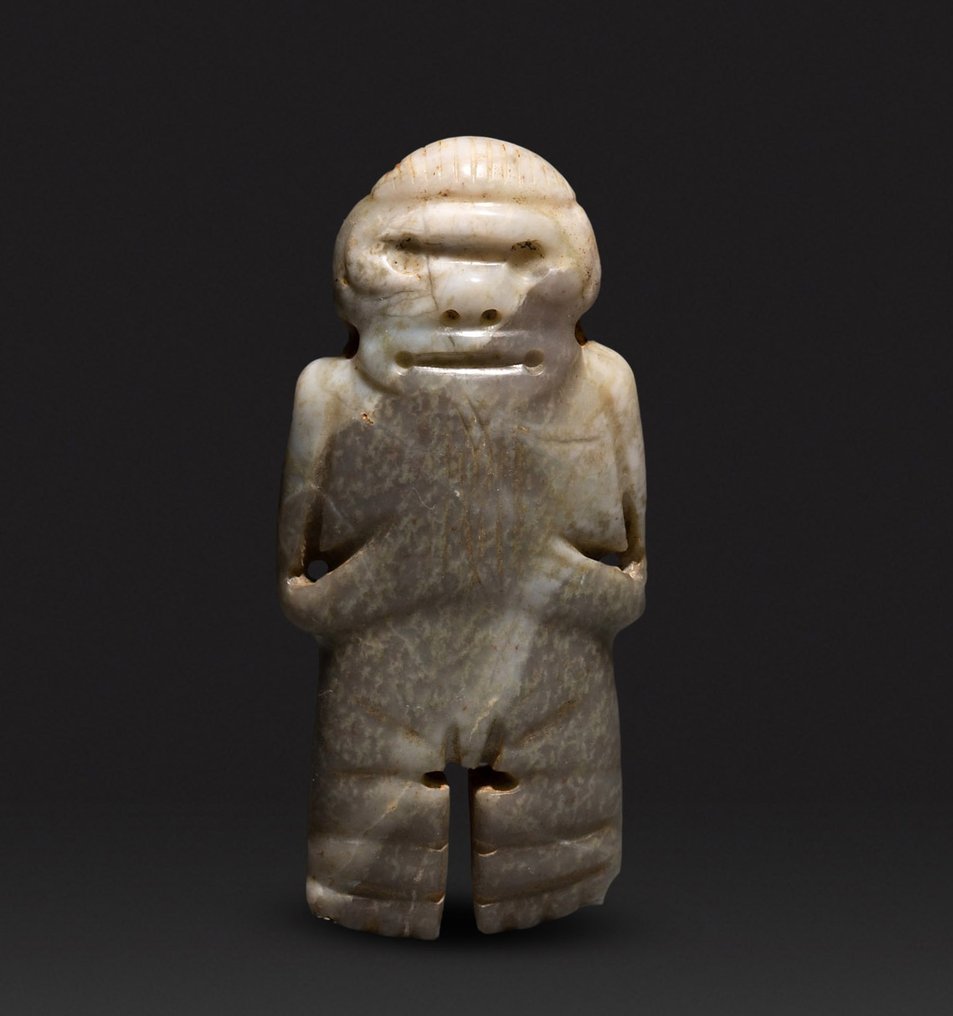
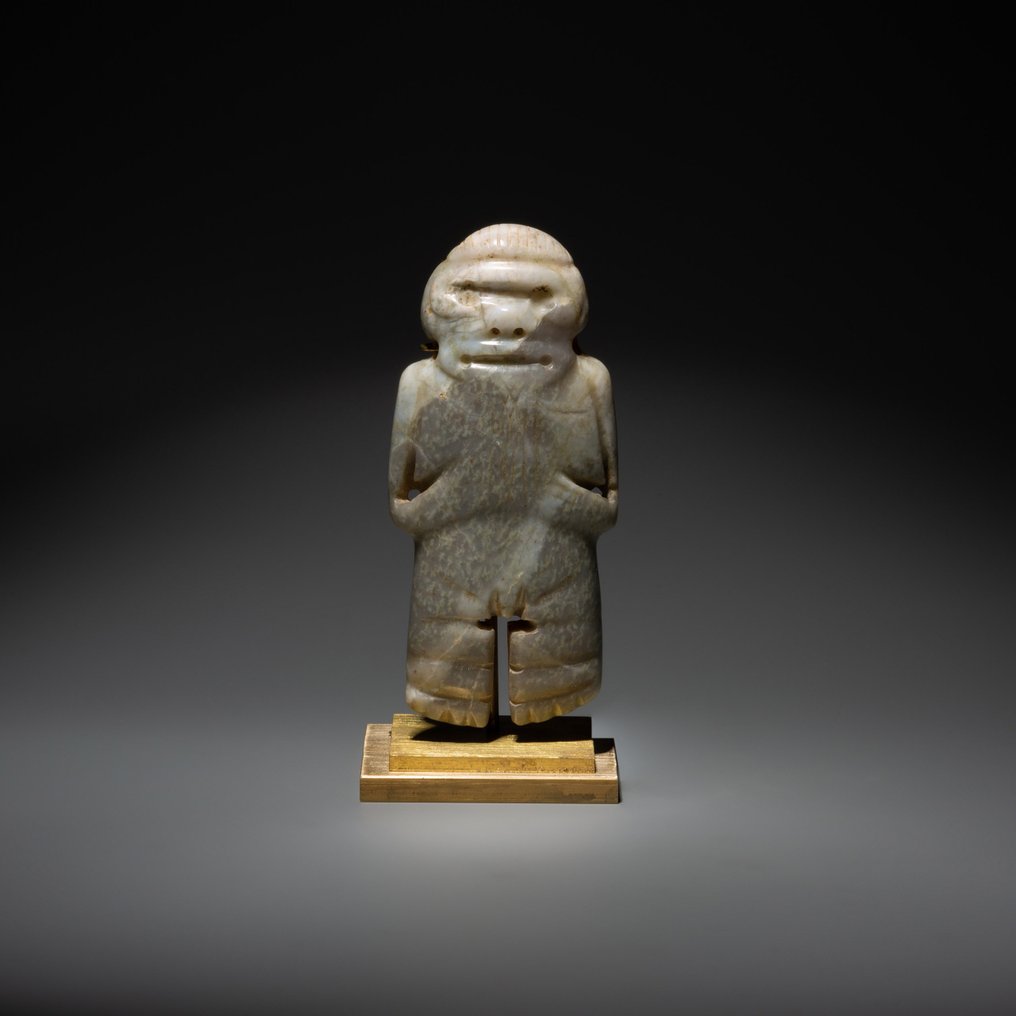

Anthropomorphic Hachoid Pendant.
- Export License -
- Intact -
Nicoya - Guanacaste, Costa Rica. c. 300 - 500 AD.
Jade stone.
9.8 cm height,
PROVENANCE:
- Private collection, USA
- Banks - Primitive Inc., Maryland, USA, September 30, 1994.
- Private collection, Remy Rey, London, United Kingdom. Acquired from the previous one.
CONDITION: Intact.
BIBLIOGRAPHY:
- FERNÁNDEZ, P.; ALVARADO, G.E. Artisans and Stones: Pre-Columbian Tools and Sculpture in Costa Rica. Central Bank of Costa Rica Museums Foundation. 2006.
- FERRERO, L. Pre-Columbian Costa Rica: archeology, ethnology, technology, art. Costa Rica Publishing. 2000.
DESCRIPTION:
A pendant carved in jade (jadeite) with a half-bump, with a flat back, depicting a female figure. It is a hachoid design, with a smooth, tapered lower part, reminiscent of the shape of sumptuary axes. In the upper half, the bust of a woman is carved in almost flat relief with a geometric design. The figure is shown with her arms folded over her belly, beneath two small breasts. The large head has animalistic features, with a wide, thick mouth and a nose that resembles the shape of a snout. The lady or deity is adorned with earflaps and a headdress. On the back, the pendant has a vertical slit. There are no perforations on the sides, so the suspension cord may have been passed through the holes drilled under the arms.
In Mesoamerica, jade necklaces were objects of great symbolic importance on a ritual and social level, a material representation of the high rank of their wearers. They were therefore used exclusively by chiefs, nobles and priests, as well as their families. These necklaces usually combined beads of different designs with a central pendant arranged vertically, carved to represent a human or animal figure, with the limbs folded over the belly, or in the form of a flat-edged axe, of a symbolic nature. There are also mixed representations that combine a flat, lower-edged axe structure with an upper part carved with the features of a character or animal (usually birds). These pendants were usually pierced on the sides, so that they hung frontally.
Green-coloured stone was considered sacred in Mesoamerica; it was associated with water, the fertility of maize and life, and thus linked to the preservation of the agricultural cycle. The most prized of these stones was jade (jadeite), considered more valuable than gold and a key religious, political and economic material throughout the region. It was reserved for the adornment of gods and kings, and even the latter could only wear it on certain occasions. Considered to be a symbol of life and purity, jade was used in particular to make jewellery such as pendants, nose rings and ear flares. Jadeite pendants were therefore highly valued objects, charged with symbolic and religious significance and only displayed by the most powerful members of society.
Jadeite is an extremely dense rock, with a relative hardness value equivalent to that of steel. Occasionally it is translucent, and its surface acquires greater chromatic intensity, as well as exceptional lustre and smoothness, after a prolonged process of weathering, polishing and burnishing. The only known source of jadeite in ancient Mesoamerica is in the valley of the Motagua River in present-day Guatemala. The first jadeite was probably found there in the form of boulders, before systematic extraction began.
Greater Nicoya is an archaeological region covering northwestern Costa Rica and the Pacific coast of Nicaragua. The Southern Sub-region, or Guanacaste, occupies the Nicoya Peninsula, the Tempisque River basin and the Guanacaste and Tilaran mountain ranges. It is an area that has been occupied by humans for some 10,000 years, with important remains of material culture in ceramics, carved stone and jade from the Tempisque period (500-300 BC). In the Bagaces period (300-800 AD) there was already a complex social organisation reflected in a greater variety of burial formulas, which included the use of large stone blocks. Around 800 AD, the territory of Guanacaste was occupied by Chorotega groups from the north, from the Valley of Mexico, who were fleeing Olmec domination. This migration brought the cultural influence of the Maya and formed the seed of the Kingdom of Nicoya, one of the main pre-Columbian chiefdoms in Mesoamerica at the time of the arrival of the Spanish.
Notes:
- The piece includes authenticity certificate.
- The piece includes Spanish Export License.
- The seller guarantees that he acquired this piece according to all national and international laws related to the ownership of cultural property. Provenance statement seen by Catawiki.
卖家故事
Anthropomorphic Hachoid Pendant.
- Export License -
- Intact -
Nicoya - Guanacaste, Costa Rica. c. 300 - 500 AD.
Jade stone.
9.8 cm height,
PROVENANCE:
- Private collection, USA
- Banks - Primitive Inc., Maryland, USA, September 30, 1994.
- Private collection, Remy Rey, London, United Kingdom. Acquired from the previous one.
CONDITION: Intact.
BIBLIOGRAPHY:
- FERNÁNDEZ, P.; ALVARADO, G.E. Artisans and Stones: Pre-Columbian Tools and Sculpture in Costa Rica. Central Bank of Costa Rica Museums Foundation. 2006.
- FERRERO, L. Pre-Columbian Costa Rica: archeology, ethnology, technology, art. Costa Rica Publishing. 2000.
DESCRIPTION:
A pendant carved in jade (jadeite) with a half-bump, with a flat back, depicting a female figure. It is a hachoid design, with a smooth, tapered lower part, reminiscent of the shape of sumptuary axes. In the upper half, the bust of a woman is carved in almost flat relief with a geometric design. The figure is shown with her arms folded over her belly, beneath two small breasts. The large head has animalistic features, with a wide, thick mouth and a nose that resembles the shape of a snout. The lady or deity is adorned with earflaps and a headdress. On the back, the pendant has a vertical slit. There are no perforations on the sides, so the suspension cord may have been passed through the holes drilled under the arms.
In Mesoamerica, jade necklaces were objects of great symbolic importance on a ritual and social level, a material representation of the high rank of their wearers. They were therefore used exclusively by chiefs, nobles and priests, as well as their families. These necklaces usually combined beads of different designs with a central pendant arranged vertically, carved to represent a human or animal figure, with the limbs folded over the belly, or in the form of a flat-edged axe, of a symbolic nature. There are also mixed representations that combine a flat, lower-edged axe structure with an upper part carved with the features of a character or animal (usually birds). These pendants were usually pierced on the sides, so that they hung frontally.
Green-coloured stone was considered sacred in Mesoamerica; it was associated with water, the fertility of maize and life, and thus linked to the preservation of the agricultural cycle. The most prized of these stones was jade (jadeite), considered more valuable than gold and a key religious, political and economic material throughout the region. It was reserved for the adornment of gods and kings, and even the latter could only wear it on certain occasions. Considered to be a symbol of life and purity, jade was used in particular to make jewellery such as pendants, nose rings and ear flares. Jadeite pendants were therefore highly valued objects, charged with symbolic and religious significance and only displayed by the most powerful members of society.
Jadeite is an extremely dense rock, with a relative hardness value equivalent to that of steel. Occasionally it is translucent, and its surface acquires greater chromatic intensity, as well as exceptional lustre and smoothness, after a prolonged process of weathering, polishing and burnishing. The only known source of jadeite in ancient Mesoamerica is in the valley of the Motagua River in present-day Guatemala. The first jadeite was probably found there in the form of boulders, before systematic extraction began.
Greater Nicoya is an archaeological region covering northwestern Costa Rica and the Pacific coast of Nicaragua. The Southern Sub-region, or Guanacaste, occupies the Nicoya Peninsula, the Tempisque River basin and the Guanacaste and Tilaran mountain ranges. It is an area that has been occupied by humans for some 10,000 years, with important remains of material culture in ceramics, carved stone and jade from the Tempisque period (500-300 BC). In the Bagaces period (300-800 AD) there was already a complex social organisation reflected in a greater variety of burial formulas, which included the use of large stone blocks. Around 800 AD, the territory of Guanacaste was occupied by Chorotega groups from the north, from the Valley of Mexico, who were fleeing Olmec domination. This migration brought the cultural influence of the Maya and formed the seed of the Kingdom of Nicoya, one of the main pre-Columbian chiefdoms in Mesoamerica at the time of the arrival of the Spanish.
Notes:
- The piece includes authenticity certificate.
- The piece includes Spanish Export License.
- The seller guarantees that he acquired this piece according to all national and international laws related to the ownership of cultural property. Provenance statement seen by Catawiki.
卖家故事
- 746
- 7
- 0
Todo correcto. Gracias
查看翻译Très beaux objets!!! Livraison rapide et soignée. Meeci👏🏻
查看翻译Top vendeur
查看翻译El objeto tenia algunos problemas que fueron solucionados por la empresa, labor excelente y pocas veces vista en este tipo de transacciones. Mis felicitaciones a la empresa
查看翻译Fast delivery, object fine. However, bad carrier: please never use again DHL express as they are "DHL slow": instead of coming to my address, they put it directly to a DHL Service Point/Locker.
查看翻译Todo correcto
查看翻译I am very happy with the ancient bronze horse. Excellent that it was delivered within a few days. My compliments to J.Bagot Arqueologia- Ancient Art, well done! Ron van Schaick
查看翻译Perfect transaction and fantastic item. Thank you.
查看翻译conforme rapide hope other thanks ++++
查看翻译Különleges eszköz, jó állapotban van, köszönöm a rendkívül gyors szállítást. Ajánlom az Eladót!
查看翻译fast delivery, good packaging
查看翻译Good seller: fast shipment, good packing and a very nice object. Thank you!
查看翻译super 💯💯💯💯💯
查看翻译Il pezzo è arrivato in condizioni perfette il pacco era protetto alla perfezione
查看翻译Buenos días, señor. ¡Gracias por las precauciones de embalaje Tip / Top! Muy contento con mi compra. ¡Gracias!
查看翻译Perfecto! :)
查看翻译Wunderbares Stück. Alles wie beschrieben. Hervorragender Kontakt.
查看翻译Extremely rapid courrier service from Barcelona to Flanders, picture was nicely and carefully packaged. Muchas gracias!
查看翻译Very fine specimen! Thanks.
查看翻译Top
查看翻译goede foto's, goede omschrijving, goed verpakt en snel verzonden.
查看翻译molto bello tutto ok
查看翻译Pezzo come da descrizione, davvero notevole. Venditore molto consigliato in quanto gentile e disponibile. spedizione molto veloce. Ottimo!
查看翻译Venditore davvero ottimo e gentile. Merce come da descrizione, spedizione veloce. Ottimo l'avere certificato di autenticità.
查看翻译


